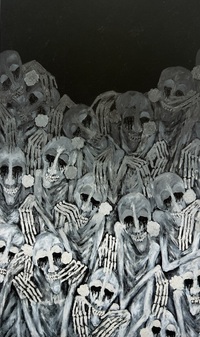His art was what I encountered first – when I was still a student. Jean Tinguely was exhibiting at the Kunsthalle Basel for the first time, and I was completely captivated by his machines. It overwhelmed me, kept me awake for nights.
With Eva Aeppli’s work, it was different: I had never heard of her. While working at the Felix Handschin Gallery in Basel, a woman kept calling. It was Eva Aeppli’s voice. And so, Handschin sent me to Paris to meet her.
Eva Aeppli’s apartment was exactly how I had always imagined a Parisian artist’s home: an old building, top floor, slanted ceilings, large windows, Paris at your feet. I still see the eerie figures sitting around the space and the old treadle sewing machine on which her art came to life.
Later, I visited Eva Aeppli in her country house outside of Paris. I wanted to do an exhibition with her. On the third day of my stay, I discovered paintings turned toward the wall, dusty and pierced. I turned them around – and saw faces, sad, gray faces – immensely powerful.
“That’s over,” Eva said. “I’ve moved on completely to my figures. I stopped painting twenty years ago.” I was shocked. These paintings were among the strongest I had ever seen. I asked her if I could show them at my gallery in Basel. She agreed only reluctantly. The exhibition was a huge success, followed by others.
Eva Aeppli always saw her work more as a message than a career. In 1962, Dino Buzzati called her the “painter of death.” She descended into the hells of the concentration camps, whose shadows still hung over Europe, painting large, haunting works – and nearly didn’t return.
But it would be more accurate to call her an “artist of humanity.” The human condition was always her subject – capturing every aspect of life became her calling. Later, she developed a sculptural technique using sewn silk filled with kapok. The way Eva Aeppli used textiles to create sculpture is unforgettable.
Viva Eva
Photos: Christian Baur, Paul Frank Talmann, Stefan Holenstein, Leonardo Bezzola
Exhibitions
1985 Galerie Klaus Littmann, Basel
Early oil paintings
1986 Art Basel, Galerie Klaus Littmann
Groupe de 48 (1969), Olga (1972), oil paintings (1960–1965)
1990 Galerie Klaus Littmann, Basel
Oil paintings, bronzes (1976–1987)
1991 Galerie Klaus Littmann, Basel
Collaboration – Eva Aeppli & Jean Tinguely











